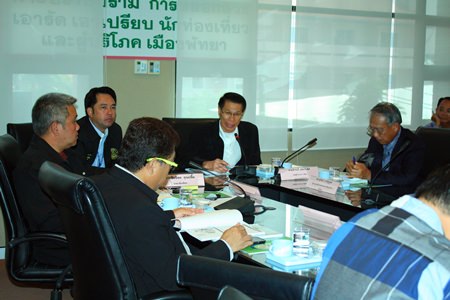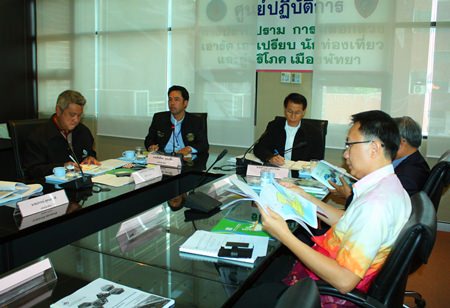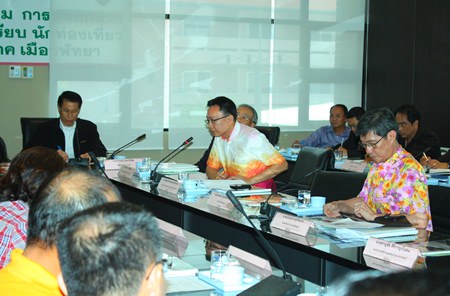Subways, high-speed trains and airports options are being considered by national planning officials who have begun a seven-month study to develop a transportation master plan for the greater Pattaya area.
Designated Areas for Sustainable Tourism Administration is paying Pisut Technology Co. 15 million baht to draft the plan to integrate transportation in Pattaya and nine surrounding sub-districts. At a March 27 meeting, Pisut consultants said initial plans include connection of high speed trains, development of park-and-ride lots, “development piers,” a unified public-transport system, and even air transport.
 Damrong Sawaengkaweelert (center), deputy director of DASTA, presides over the meeting.
Damrong Sawaengkaweelert (center), deputy director of DASTA, presides over the meeting.
Mayor Itthiphol Kunplome, who early in his first term suggested Pattaya needs an elevated “skytrain” system, led audience members in suggesting the consultants should study a subway system linking Pattaya-area communities.
“I believe subway trains would help solve traffic issues very well since there is an increase in the number of cars exiting and entering Pattaya city every year,” agreed Pattaya Business & Tourism Association President Sinchai Wattanasartsathorn.
Consultants said the their report will take into consideration transportation initiatives already being built or in planning, including high-speed trains, the Buraphawithi-Pattaya highway, Pattaya-Maptaput highway and proposed bypass tunnels under three Sukhumvit Road intersections. The final plan will split proposed projects into five development phases.
DASTA began work on redeveloping Pattaya in August 2011, calling for 15 billion baht in funding over 10 years for 132 projects in Pattaya and nine surrounding sub-districts. Very little of the plan has been implemented, as national politicians have shown little enthusiasm to fund the long list of pork-barrel projects largely suggested by Itthiphol, including the skytrain idea. In 2012, the Cabinet axed 56 projects and cut the total package by 38.5 percent to 9.2 billion baht over eight years.
Set up by a 2003 royal decree, DASTA was given a mission to integrate and oversee tourism development in areas designated to have superb natural environments, cultural and traditional importance and have been developed for tourism purposes.
DASTA Deputy Director Dumrong Saengkaweelert and Thaweepong Wichaidit, manager for the Pattaya Special and Adjacent Areas Office, said a comprehensive transportation master plan is needed desperately in Pattaya, which now attracts more than 9 million visitors a year. Streets and highways, they said, have been simply unable to cope with the meteoric growth in tourist numbers over the past decade.
“It is great that DASTA is supporting us here since we can use the master plan to connect over 930 sq. kilometers of all nine areas to build a citywide transportation system,” Itthiphol said. “Each area can present their plans to the working committee for consideration in order to build a consistent master plan for each area’s development to proceed in the same direction.”






